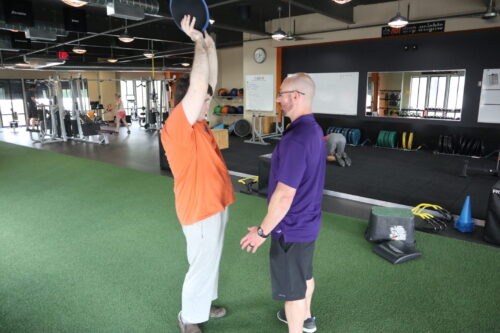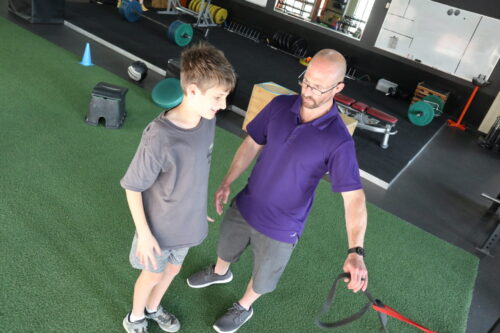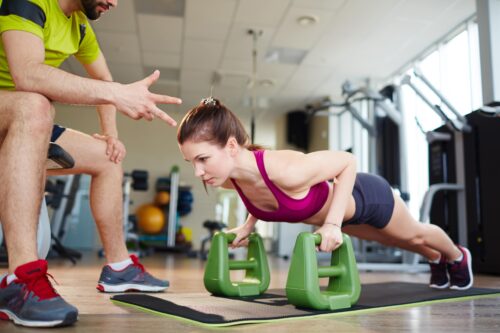Meaningful Fitness Programs for the Autism and Neurodivergent Population

Strength training represents a critical yet often overlooked component of healthcare and independence for individuals with autism spectrum disorder (ASD) and related neurodiversity. While autism presents across a broad spectrum, from those requiring constant support to independent self-advocates, certain constants emerge regarding physical fitness needs and approaches.
While fitness is occasionally given a general regard of “good” or “beneficial” for the ASD and neurodivergent populations, both access and best programming practices are seldom prioritized. The result is a situation in which “fitness” becomes an abstract, nebulous area of life that goes unaccounted for. Given the critical role fitness, resistance training in particular has for general populations, the preventative and proactive health benefits hold true for ASD and neurodivergent individuals as well.
In addition to the issue of accessibility, developing fitness programs that are both meaningful and effective is a necessity. Given the myriad modalities of fitness; from yoga to Pilates to cycling to rock climbing to competitive sports, there does require some discussion about general and specific outcomes, along with comparison and contrast between different types of physical fitness. There are also stark differences between sports-based and exercise-based physical activities.
The purpose of this article is to highlight resistance-based exercise as this modality, when implemented safely and appropriately, will have the highest benefit to general health, body composition, and generalization to activities of daily living.
Understanding the PAC Profile Framework
The foundation of effective fitness programming for individuals with autism rests on understanding and addressing three essential components through the PAC Profile™:
Physical skills reflect an individual’s ability to perform exercises independently, demonstrating motor control through a healthy range of motion. Many individuals with autism experience neurological and neuromuscular complications that manifest as low muscle tone, core strength deficits, and motor control challenges.
Adaptive skills encompass motivation and engagement levels during exercise sessions. While these may fluctuate, understanding an individual’s general range of focus and meaningful participation capabilities is crucial for program design.
Cognitive skills involve both neurological aspects (communication, memory, information processing) and kinesthetic awareness (body positioning, motor imitation). Many individuals with autism require specific, concise instructions and ongoing visual demonstrations.
While physical, adaptive, and cognitive attributes can be assessed and addressed individually, it is important to understand that there is considerable interaction between them. With respect to physical and adaptive abilities, a higher level of motivation is likely to result in better performance of an exercise. Motivation may not override deficits in strength and motor control, however a motivated athlete is much more likely to perform at their best current level of ability.
Equally important is the interaction between adaptive and cognitive functioning. Expectation management is a big deal. We want our athletes to have an understanding of
- How the exercise is performed
- When they are going to do the exercise
- What the schedule of events will be (exercise, then rest break, then a second set)
Clear expectations can reduce anxiety and increase focus, particularly athletes who perseverate around routine. Building in reinforcement around neutral or less-preferred exercises also serves to create meaningfulness when we consider that exercise, when not tied to a specific goal, can be rather abstract.

Essential Movement Patterns and Exercise Selection
There are no “autism-specific” exercises. This is fortunate, as we can develop fitness programs based on exercises and variations that have consistently and near-universally proven effective for neurotypical populations. These are fundamental, “compound” movements that engage the largest muscle groups in the body. They have a high transference or generalization to activities of daily living (ADLs) because they strengthen the greatest amount of muscle per area, and address many motor patterns similar to everyday activities.
Another common misconception is the distinct characteristics of exercise with respect to strengthening “versus” cardio. For certain, there are considerable differences between these, particularly as we head towards extremes (comparing powerlifting to a 5k, for example). However anyone who has ever done a challenging 3-4 sets of squats, push-ups, or cable rows knows the experience of increased heartrate and heavier breathing (a cardio effect).
Below are the essential/foundational exercise patterns to address in a well-rounded program;
- Squatting: A fundamental movement used multiple times daily, proper squatting strengthens the lower body and can enhance gait patterns
- Pushing/Pressing: Develops upper body strength and shoulder stability
- Pulling: Improves shoulder and upper back strength while addressing grip dysfunction
- Carrying: Directly translates to daily tasks like managing groceries or laundry
Exercise selection must prioritize movements that will generalize beyond the fitness session. Random exercise selection or complex “balance” and “sensory” activities rarely yield measurable outcomes, particularly in teen and adult populations. Resistance training through healthy ranges of motion for effective volume (sets and reps per session) will have the greatest effectiveness.
Implementation Challenges and Solutions
Several common assumptions can derail effective fitness programming for individuals with autism:
- The “all exercises are equal” misconception: Exercise selection must be purposeful, with clear intended outcomes and appropriate progression paths.
- Program-only focus: Having a written program isn’t sufficient without understanding how to modify, cue, and progress exercises based on individual capabilities.
- Overemphasis on “fun”: While sessions should be reinforcing, constant gamification can be counterproductive, especially for teens and adults.
- Excessive variety: Mastery of baseline skills should precede variety, as many individuals with autism require extended practice time with each exercise.
Adaptive Challenges
This discussion would not be complete without addressing the important consideration of adaptive functioning. For many individuals with autism, new activities and challenges can be aversive. The expectations, environment, and interaction (coaching) must take a meet-them-where-they’re at approach.
An individual-centered program may require limiting the time and amount of exercises in the initial session(s), gradually increasing both over time. Strategies including secondary reinforcers, choice of exercise order, visual schedules, and age-appropriate behavior-specific praise can bridge the gap between unwillingness and meaningful participation.
There is a list of general behavior-support strategies and individualized implementation that are, while important, beyond the scope of this article. As a beacon, many individuals who initially find exercise aversive have a gradual and profound shift when positive support strategies are used effectively.

Aging Considerations and Preventative Healthcare
For adults with autism, strength training takes on additional importance as preventative healthcare. The ASD population faces higher potential risks of medical complications, often exacerbated by sedentary lifestyles. Progressive resistance training can:
- Increase and maintain lean body mass
- Reduce fall risk through improved strength and stability
- Enhance independence in daily activities
- Provide long-term health benefits
While “balance” is often cited as crucial for fall prevention, supportive strength and mobility are the primary factors in both preventing falls and recovering from them.
Best Practices for Implementation
Successful strength training programs for individuals with autism should:
- Maintain consistency in labels, language, and exercise selection
- Provide appropriate choices and clear contingencies
- Use behavior-specific praise
- Focus on progressive loading within current capability levels
- Schedule regular sessions (minimum once weekly) for physical, adaptive, and cognitive progress
- Modify exercises to match current abilities while maintaining movement integrity
- Separate exercise from recreation while understanding the value of both
The development of strength and motor skills often requires extended repetition at similar modification levels. While progress may occur slowly, consistent practice enables individuals with autism to master and generalize these essential physical abilities.
Conclusion
While there is much more than often expected to implement truly meaningful fitness programs, the general and specific health and quality of life benefits cannot be overstated. Even if an individual engages in one or more physical activities or sports, resistance training using the foundational movements will have the greatest short and long-term benefit for development and maintenance of lean body mass, injury prevention, and independent movement. Add to these the cognitive and socio-emotional benefits, and the need for prioritization of exercise becomes clear.
Understanding and implementing effective strength training programs for individuals with autism requires a multidisciplinary approach combining exercise science, behavioral support, and individualized programming. When properly structured and consistently delivered, strength training becomes not just exercise but a critical life skill supporting independence, health, and quality of life across the lifespan.

ERIC CHESSEN
M.S, Founder, Autism Fitness
Director of Neuroadaptive Programming, Inclusive Fitness
Youtube: https://youtube.com/TheAutismFitness
Website: https://www.autismfitness.com/

